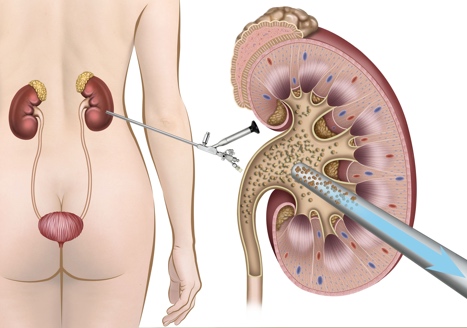Kidney STONE Calculator for Percutaneous Neprolithotomy
The kidney STONE calculator will tell you the probability of a stone-free outcome after the first percutaneous nephrolithotomy (PCNL). You only need an actual CT scan of the patient - the rest is on our side. Read on and learn more about the causes of kidney stones and the use of the STONE scoring system.
We try our best to make our Omni Calculators as precise and reliable as possible. However, this tool can never replace a professional doctor's assessment.
STONE scoring system (nephrolithometry)
Okhunov et al. first proposed the STONE scoring system in 2013. To use the scale, you need to have your patient's actual CT (computerized tomography) scan result. Then we assess the patient's state using five criteria that form the mnemonic STONE.
- Stone size (mm2) - calculated as stone length multiplied by width (length × width).
- Tract length (mm) - defined as the distance between the stone center and the skin on CT film at 0°, 45°, and 90°.
- Obstruction (hydronephrosis) - check if the hydronephrosis is present and what stage it represents.
- Number of calyces with calculi.
- Essence/stone density - measured in Hounsfield units (HU).
The STONE scale allows for predicting the outcome of the percutaneous nephrolithotomy. The result describes what percentage of patients will be stone free after the first procedure.
Using the kidney STONE calculator
Using our kidney STONE calculator is intuitive and easy!
- Before working with this calculator, ensure you have the patient's CT scan.
- Input the stone size. How do I calculate the kidney stone size?
- Enter the tract length.
- Fill in the presence of hydronephrosis and, if so - the severity of it.
- Enter the number of calyces affected. You might notice 'a staghorn stone' term. A staghorn stone is a large stone that takes up more than one branch of the collecting system in the renal pelvis of the kidney.
- Input the stone density measured in Hounsfield units.
- After filling in the whole nephrolithometry parameters, your result is ready. You immediately see the probability of success - a stone-free outcome.
Percutaneous nephrolithotomy
Percutaneous nephrolithotomy (PCNL) is a type of kidney stone removal procedure. We usually use it with large stones (>1.5 cm) or when other, less-invasive methods have failed or can't be done.
The procedure - step by step
PCNL is usually done under general anesthesia. Let's review the key steps in the procedure:
- Insertion of the tube (sheath) through the skin incision on the back of the kidney area. The end of the tube lands in the kidney's calyx.
- Insertion of the instruments through the sheath. The tools can be:
- A telescope to visualize the stone;
- A laser instrument (or another type) to break up the stone before removal;
- A device to remove the stone fragments from the patient's body.
- Placement of the nephrostomy tube and/or ureteral stent to provide urine flow after the procedure. These are left for several days and removed during one of the follow-up appointments.

Potential complications of this kidney stone removal procedure include:
- Bleeding.
- Injury to kidney and/or other close organs.
- Infection.
- Failure to remove the stone.
Other kidney stone recurrence factors
STONE nephrolithometry considers mainly CT imaging parameters and refers to a single case of kidney calculi. However, the patient might still experience kidney stone ailments in the future. Risk factors for recurring kidney stones are:
- Personal history of kidney stones.
- Family history of kidney stones.
- Anatomical abnormalities in the urinary tract (the ones causing obstruction) - e.g., benign prostate hyperplasia or prostate cancer.
- Frequent urinary tract infections.
- Sedentary lifestyle and being overweight.
- Diet rich in high protein foods (especially animal protein) or sodium, vitamin D, vitamin C, or calcium supplement overdosing.
- Concomitant disorders - e.g., hyperparathyroidism, small intestine diseases, gout diagnosis.
- Use of certain drugs, such as diuretics. or certain antibiotics.
FAQs
How do I calculate kidney stone size?
To calculate kidney stone size for the STONE scoring system:
- You must have a CT (computed tomography) scan ready.
- Measure the length and width of the calculus (in millimeters - mm).
- Multiply the width (W) by length (L):
size = W × L
Are kidney stones genetic?
You can inherit a predisposition to kidney calculi. However, a healthy lifestyle can save you from stones for decades. It's easier to prevent it than to treat it!
How do kidney stones affect the filtration rate?
Kidney stones usually slightly decrease the glomerular filtration rate (GFR). Very rarely can they cause kidney disease (a severe reduction of kidney function). The best way to avoid the progression of the disease is to treat even small calculi effectively.
Can too much vitamin D cause kidney stones?
Short answer, yes. Maintaining an abnormally high level of vitamin D (vitamin D toxicity or vitamin D hypervitaminosis) will cause an excess of calcium to run in your blood, which can then progress to the formation of the kidney calculi.